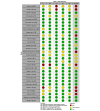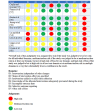Social Media and mHealth Technology for Cancer Screening: Systematic Review and Meta-analysis
- PMID: 34328423
- PMCID: PMC8367160
- DOI: 10.2196/26759
Social Media and mHealth Technology for Cancer Screening: Systematic Review and Meta-analysis
Abstract
Background: Cancer is a leading cause of death, and although screening can reduce cancer morbidity and mortality, participation in screening remains suboptimal.
Objective: This systematic review and meta-analysis aims to evaluate the effectiveness of social media and mobile health (mHealth) interventions for cancer screening.
Methods: We searched for randomized controlled trials and quasi-experimental studies of social media and mHealth interventions promoting cancer screening (breast, cervical, colorectal, lung, and prostate cancers) in adults in MEDLINE, Embase, PsycINFO, Scopus, CINAHL, Cochrane Central Register of Controlled Trials, and Communication & Mass Media Complete from January 1, 2000, to July 17, 2020. Two independent reviewers screened the titles, abstracts, and full-text articles and completed the risk of bias assessments. We pooled odds ratios for screening participation using the Mantel-Haenszel method in a random-effects model.
Results: We screened 18,008 records identifying 39 studies (35 mHealth and 4 social media). The types of interventions included peer support (n=1), education or awareness (n=6), reminders (n=13), or mixed (n=19). The overall pooled odds ratio was 1.49 (95% CI 1.31-1.70), with similar effect sizes across cancer types.
Conclusions: Screening programs should consider mHealth interventions because of their promising role in promoting cancer screening participation. Given the limited number of studies identified, further research is needed for social media interventions.
Trial registration: PROSPERO International Prospective Register of Systematic Reviews CRD42019139615; https://www.crd.york.ac.uk/prospero/display_record.php?RecordID=139615.
International registered report identifier (irrid): RR2-10.1136/bmjopen-2019-035411.
Keywords: cancer screening; digital health; mHealth; mass screening; mobile phone; social media.
©Arlinda Ruco, Fahima Dossa, Jill Tinmouth, Diego Llovet, Jenna Jacobson, Teruko Kishibe, Nancy Baxter. Originally published in the Journal of Medical Internet Research (https://www.jmir.org), 30.07.2021.
Conflict of interest statement
Conflicts of Interest: None declared.
Figures








References
-
- World Health Organization . Global Difusion of eHealth: Making Universal Health Coverage Achievable. Report of the Third Global Survey on eHealth. Geneva: World Health Organization; 2016. pp. 1–160.
-
- Moorhead SA, Hazlett DE, Harrison L, Carroll JK, Irwin A, Hoving C. A new dimension of health care: systematic review of the uses, benefits, and limitations of social media for health communication. J Med Internet Res. 2013;15(4):e85. doi: 10.2196/jmir.1933. http://www.jmir.org/2013/4/e85/ - DOI - PMC - PubMed
-
- Maher CA, Lewis LK, Ferrar K, Marshall S, De Bourdeaudhuij I, Vandelanotte C. Are health behavior change interventions that use online social networks effective? A systematic review. J Med Internet Res. 2014;16(2):e40. doi: 10.2196/jmir.2952. http://www.jmir.org/2014/2/e40/ - DOI - PMC - PubMed
-
- Bull SS, Levine DK, Black SR, Schmiege SJ, Santelli J. Social media-delivered sexual health intervention: a cluster randomized controlled trial. Am J Prev Med. 2012 Nov;43(5):467–74. doi: 10.1016/j.amepre.2012.07.022. http://europepmc.org/abstract/MED/23079168 - DOI - PMC - PubMed
Publication types
MeSH terms
Grants and funding
LinkOut - more resources
Full Text Sources
Medical
Miscellaneous

